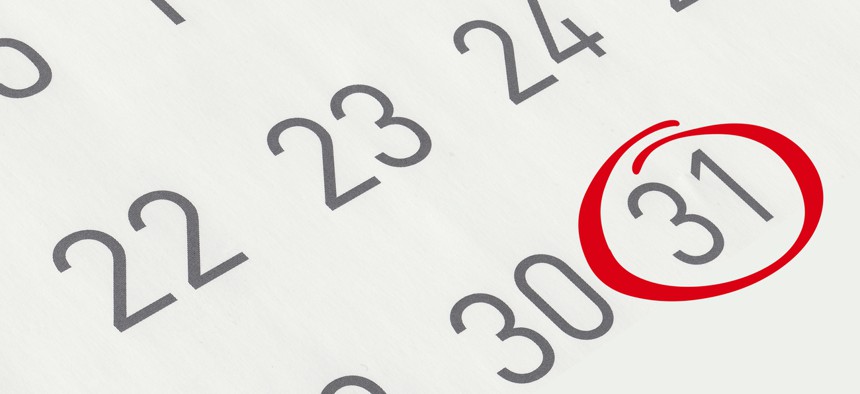
Shutterstock
Best Dates to Retire 2021
Our annual look at the optimum days to bid farewell to a career in government.
What does the end of the month and the end of a two-week leave period have in common for people who work in the federal government? If they fall on the same date, they become a very good date to retire.
Download the Best Dates to Retire Calendar
There will be several times in 2021 when the end of the month is also at or near the end of a leave period. Here are those great dates:
Saturday, Jan. 30
Saturday, Feb. 27
Saturday, July 31
Friday, Dec. 31
Of these, the date that tends to be the most popular is the end-of-year “magic” retirement date. In 2021 that’s Friday, Dec. 31.
Why is this such a great date? Let me count the ways:
- It’s the end of the leave year. If you don’t take any leave in the 26 leave periods of 2021 and you carry over 240 hours (or whatever balance you are entitled to keep in the new year) from 2020, it is possible to be paid for 448 hours of unused annual leave in a lump sum payment.
- This payment is usually paid within six to eight weeks of your retirement date, which means it will be taxable in 2022, not the 2021 tax year.
- All of the lump sum leave payment will be paid at the 2022 pay rate (assuming there is a general pay adjustment in 2022).
- It’s New Year’s Eve. What a great way to start 2022!
One word of caution if you’re retiring after you have reached age 72. Your retirement date may impact required distributions from your Thrift Savings Plan account. While you were working and contributing to the TSP, you were not required to take distributions from your TSP account. But you will face required minimum distributions after your retirement.
For a TSP participant who is already past age 72 and retiring on Dec. 31, 2021, the TSP is required to pay the first RMD by April 1 of the following year—in this case April 1, 2022. The participant will also be required to take an RMD for 2022 before Dec. 31, 2022. This would mean they would be required to take both 2021 and 2022 RMD in the 2022 tax year. But if they retired on Jan. 31, 2022, the first RMD would not be required until April 1, 2023.
For employees covered under either the Federal Employees Retirement System or the Civil Service Retirement System, the end of the month is always a good date to retire.
However, retirements under CSRS (and CSRS Offset) commence on the next day after your retirement date if the retirement is effective on the first, second or third day of the month. This is not true of FERS. So the following are additional days that are great dates in 2021 for those retiring under CSRS or CSRS Offset:
- Jan. 1: A holiday, a Friday, and the end of leave period 26 of 2020. (For most federal employees, leave periods end on Saturday, but if you complete your 80 hours of work by close of business Friday, you will accrue your final leave accrual.)
- July 2: A Friday at the end of leave period 13.
- Dec. 3: A Friday at the end of leave period 24
Of course, the first three days of any month could work, even if it is a Wednesday or the middle of a leave period. Remember, however, that if you retire on a Saturday or Sunday that’s in the first three days of the month (and you normally work Monday to Friday) you won’t be paid your salary for those days and your first retirement check will be prorated by one to three days. So, for example, Friday, Oct. 1, 2021 is a better date than Sunday, Oct. 3 even though both dates would allow your retirement to commence in October.
Remember, these rules may not apply in the same way for postal employees and others who may follow a different leave calendar. Also, disability, survivor benefits, deferred and discontinued service retirements will commence on a different date than described above. Federal employees such as law enforcement officers, air traffic controllers and firefighters are subject to mandatory retirement and their retirement benefits start the day after separation if they’re retiring in the month that is subject to mandatory separation.
If you’re retiring under the MRA+10 provisions of FERS and you choose to postpone receiving your benefit, then your date of separation could be any date you like, since you won’t be receiving your benefit until later. Under MRA+10 requirements, your annuity is reduced for each month you are under age 62. To avoid the reduction, you can postpone receiving the first payment.
Remember, you can find a great date to retire in any month of the year. It might be your birthday or a work anniversary date that you want to celebrate. Or maybe you want to time your retirement to coincide with a move to a new location.
Here’s a downloadable calendar to help you plan your best date for a 2021 retirement. Use the suggestions above to see how your retirement will coordinate with the end of the month, the end of the leave period, the end of the week, and the end of the leave year.
Download the Best Dates to Retire Calendar
Correction: The original version of this column indicated July 2 was a Saturday. It is a Friday.
NEXT STORY: TSP to Increase Default Contributions, and More







